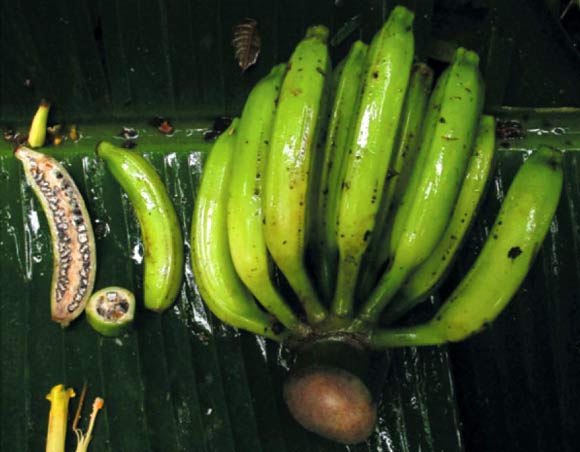A team of Thai botanists has announced the discovery of what they say is a new species of wild banana.
The newly-discovered species belongs to Musa, a large genus in the family Musaceae containing more than 70 species of bananas and plantains.
The species’ scientific name – Musa nanensis – honors the Thai northern province of Nan, where the type specimens of this new species were collected. The common name is the Kluai Si Nan (means ‘banana pride of Nan’).
According to Dr Sasivimon Swangpol of Mahidol University and her colleagues, Musa nanensis is a perennial herb, 4.9 to 9.8 feet (1.5 to 3 m) in height. Its flowering time is year round.
Fruits are 2.8 inches (7 cm) long and 0.6 inches (1.5 cm) wide. They are straight to curved, angular with prominent ridges at maturity.
Each bunch has 3-10 hands and each hand contains 4-10 bananas. Seeds are irregular, sharp angular, 3-5 mm by 2-5 mm by 2-3 mm.
“The new taxon possesses generally thicker leaves than other Musa species,” Dr Swangpol and co-authors wrote in a paper in the journal Systematic Botany.
“In addition, Musa nanensis has various epidermal cell shapes with relatively longer hypodermal cells on its adaxial side as compared to corresponding epidermal cells.”
Several specimens of Musa nanensis were collected from only one locality close to the Thai-Lao border in the province of Nan. However, it is expected that the new species will be found across the border in Laos PDR.
“The taxon was found at 2,740 feet (835 m) altitude in the dry evergreen forest, by streams in a valley in a lower mountainous forest,” the scientists said.
According to the team, Musa nanensis is an extremely rare plant.

Musa nanensis. A – clump of pseudostems; B – leaf bases; C – cross-section of petiole canal; D – male inflorescence; E – female inflorescence; F – male flowers, tepals fused at base and six anthers fused at base; G – female flower, tepals fused at base and six sterile anthers or five sterile with one fertile anther fused at base; H – transverse and longitudinal sections of fruits and a hand. Image credit: N. Sukkaewmanee.
“Since the first collection in 2002 until 2012, it has been seen by the authors only at the type locality, where there are fewer than 50 plants,” Dr Swangpol and her colleagues wrote in the paper.
“In addition, its habitat in the dry evergreen forest in Tambon Dong Phaya, Amphoe Bo Kluea of Changwat Nan is threatened by heavy deforestation and fragmentation.”
“On the basis of IUCN, the plant should be listed as critically endangered and, therefore, considered to be in need of urgent conservation.”
_____
Sasivimon Chomchalow Swangpol et al. 2015. Musa nanensis, a New Banana (Musaceae) Species from Northern Thailand. Systematic Botany 40 (2): 426-432; doi: 10.1600/036364415X688790









